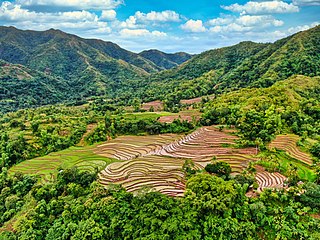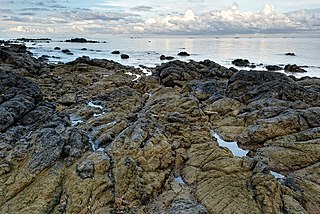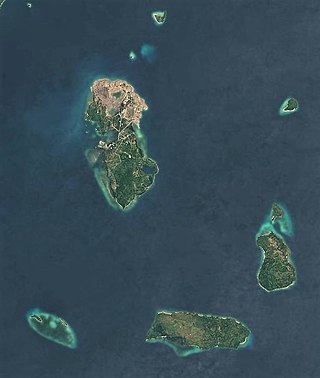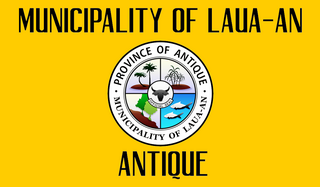
Antique, officially the Province of Antique, is a province in the Philippines located in the Western Visayas region. Its capital is San Jose de Buenavista, the most populous town in Antique. The province is situated in the western section of Panay Island and borders Aklan, Capiz and Iloilo to the east, while facing the Sulu Sea to the west.

Dauin, officially the Municipality of Dauin is a 4th class municipality in the province of Negros Oriental, Philippines. According to the 2020 census, it has a population of 30,018 people.

Altavas, officially the Municipality of Altavas, is a 4th class municipality in the province of Aklan, Philippines. According to the 2020 census, it has a population of 25,639 people.

Batan, officially the Municipality of Batan, is a 4th class municipality in the province of Aklan, Philippines. According to the 2020 census, it has a population of 33,484 people.

Madalag, officially the Municipality of Madalag, is a 4th class municipality in the province of Aklan, Philippines. It is Aklan's largest municipality by land area and also the most sparsely populated. According to the 2020 census, it has a population of 18,890 people.

Malay, officially the Municipality of Malay, is a 1st class municipality in the province of Aklan, Philippines. It is the richest municipality in the province in terms of revenue. According to the 2020 census, it has a population of 60,077 people, making it the second most populous municipality in Aklan. It is the northernmost town on the island of Panay and the youngest amongst all municipalities in Aklan province. The resort island of Boracay is part of the municipality.

Nabas, officially the Municipality of Nabas, is a 4th class municipality in the province of Aklan, Philippines. Nabas serves as the arrival gateway of Boracay Airport. According to the 2020 census, it has a population of 40,632 people, making it the fifth most populous town in Aklan Province..

New Washington, officially the Municipality of New Washington, is a 3rd class municipality in the province of Aklan, Philippines. According to the 2020 census, it has a population of 47,955 people.

Tangalan, officially the Municipality of Tangalan, is a 5th class municipality in the province of Aklan, Philippines. According to the 2020 census, it has a population of 23,704 people.

Pulupandan, officially the Municipality of Pulupandan, is a 3rd class municipality in the province of Negros Occidental, Philippines. According to the 2020 census, it has a population of 30,117 people.

Caluya, officially the Municipality of Caluya, is a 1st class municipality in the province of Antique, Philippines. According to the 2020 census, it has a population of 38,908 people, making it the sixth most populous municipality in the province.

Culasi, officially the Municipality of Culasi, is a 3rd class municipality in the province of Antique, Philippines. According to the 2020 census, it has a population of 44,494 people. Making it fourth most populous municipality in the province of Antique and third largest municipality in terms of land area, with a total area of 228.56 square kilometers.

Hamtic, officially the Municipality of Hamtic, is a 3rd class municipality in the province of Antique, Philippines. According to the 2020 census, it has a population of 52,685 people. Making it third most populous municipality in the province of Antique.

Laua-an, officially the Municipality of Laua-an, is a 4th class municipality in the province of Antique, Philippines. According to the 2020 census, it has a population of 26,580 people. Making it 12th most populous municipality in the province of Antique. Laua-an celebrates its Pahinis Festival every January.

Libertad, officially the Municipality of Libertad,, is a 5th class municipality in the province of Antique, Philippines. According to the 2020 census, it has a population of 17,507 people, making it the 17th most populous municipality in the province of Antique.

Patnongon, officially the Municipality of Patnongon, is a 3rd class municipality in the province of Antique, Philippines. According to the 2020 census, it has a population of 38,329 people.

Sebaste, officially the Municipality of Sebaste, is a 4th class municipality in the province of Antique, Philippines. According to the 2020 census, it has a population of 18,816 people. Making it 16th most populous municipality in the province of Antique.

Tibiao, officially the Municipality of Tibiao, is a 4th class municipality in the province of Antique, Philippines. According to the 2020 census, it has a population of 28,703 people.

Pandan, officially the Municipality of Pandan, is a 4th class municipality in the province of Catanduanes, Philippines. According to the 2020 census, it has a population of 21,473 people.
The Bugang River is a river situated in the northwest of Panay island in the Philippines. It is located in municipality of Pandan, Antique which is noted for its distinction as the "Cleanest Inland Body of Water" in the country.























